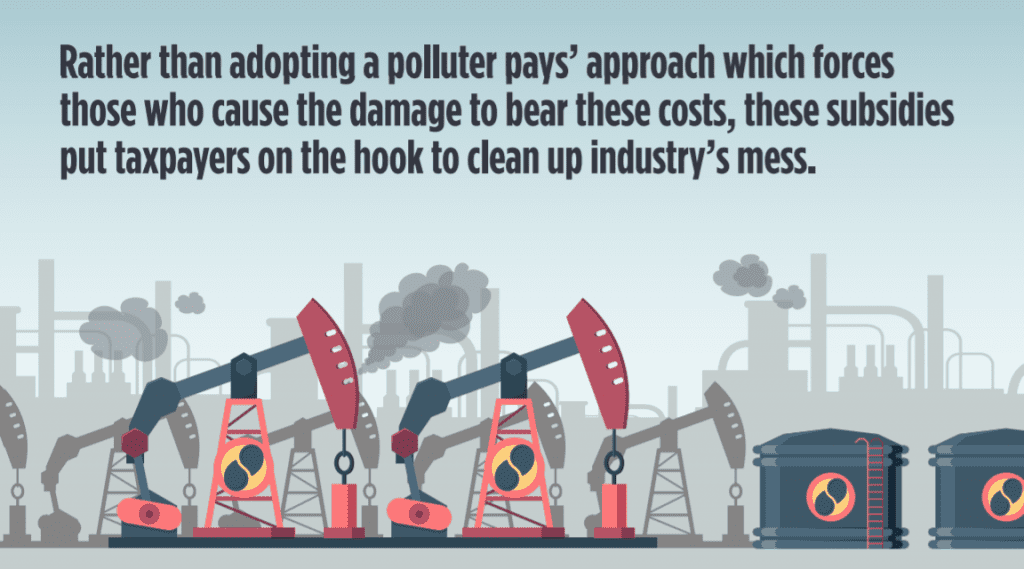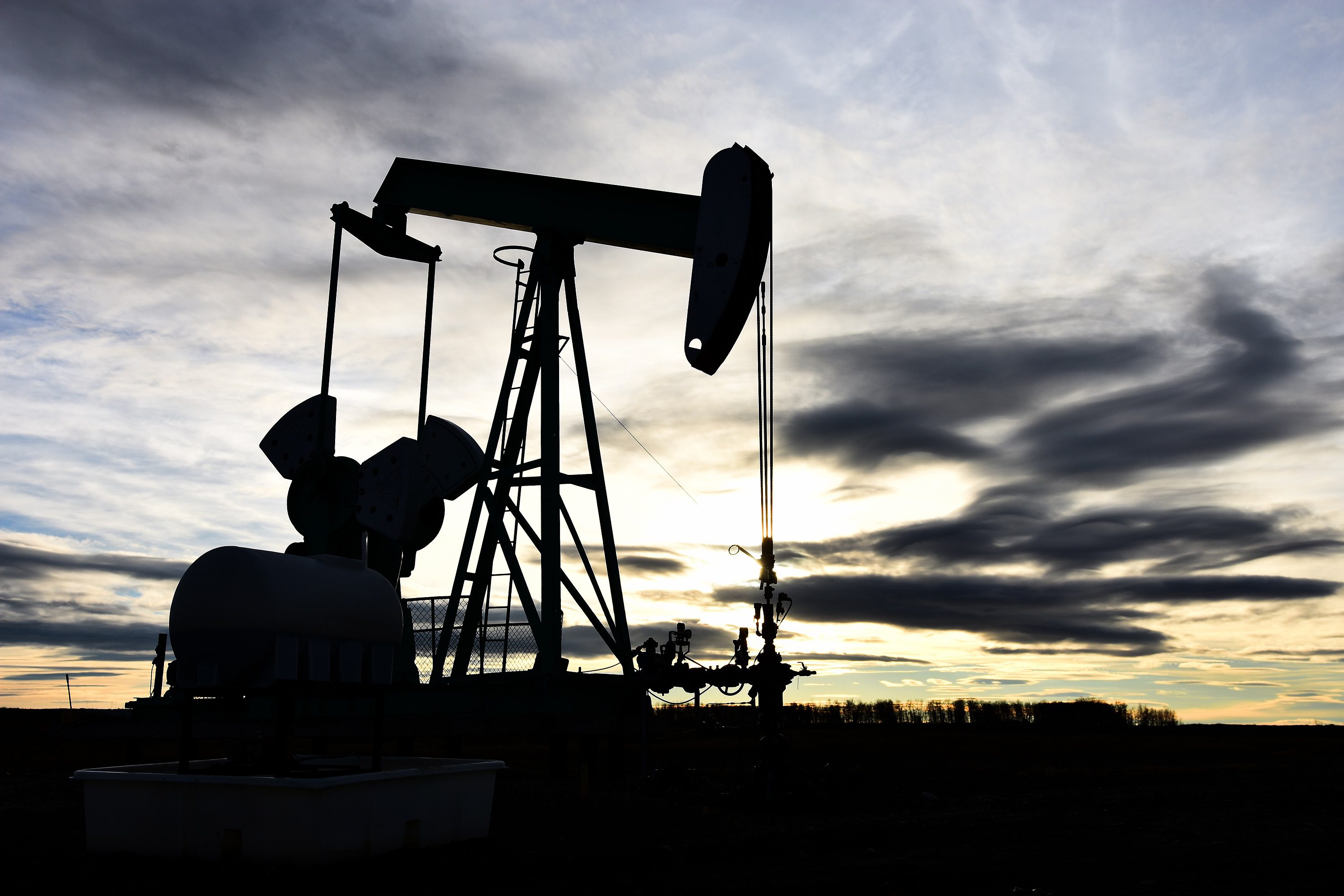Last spring, we released a report – Paying Polluters: Federal Financial Support to Oil and Gas in 2020 – that revealed the federal government announced a minimum of nearly $18 billion to the oil and gas sector in 2020. (It’s worth noting that due to a lack of transparency and public reporting, this number is likely a large underestimate of total support.)
How did we get to ~$18 billion?
You can find the complete list of federal supports announced in 2020 in the report, but here are the major categories we were able to track.
$8.1 billion in public finance (loans, loan guarantees, insurance) through Export Development Canada
This public financing provided by crown corporation Export Development Canada supports the operations of oil and gas companies both domestically and internationally (read more about Export Development Canada here). Notably, the agency loaned up to $500 million for the Coastal GasLink Pipeline, a project opposed by hereditary leaders from all five clans of the Wet’suwet’en Nation.
$5.25 billion to finance the construction of Trans Mountain pipeline expansion
Again through Export Development Canada (through a special program administered by the agency but where decision-making rests with Cabinet). The projected total cost of the Trans Mountain pipeline expansion project has skyrocketed to over $16 billion.
$1.7 billion to clean up orphan and inactive oil and gas wells
The bulk of this went to cleaning up inactive wells in Alberta, which are owned by viable companies who have neglected to pay the clean-up costs of their operations for decades. Rather than adopting a polluter pays approach, forcing those who cause the damage to bear these costs, these subsidies put taxpayers on the hook to clean up. Furthermore, the promised job creation hasn’t happened. Companies put their own remediation programs on hold while they waited for the government to pay to clean up their mess.
$812 million to pay companies to reduce their emissions and invest in “clean tech”
The majority of this ($675 million) was for oil and gas companies to reduce their methane emissions through the Emissions Reduction Fund. Though reducing methane emissions is critical to tackling the climate crisis, these measures aren’t expensive for companies to pay for. In addition, we already have regulations in place to achieve methane reductions, so we are essentially subsidizing compliance with existing rules. The rest of the spending was through a variety of programs designed to fund the development and commercialization of ‘clean technology’ for the oil and gas sector, run through various agencies and funds. By taking on the cost of reducing emissions, we are not holding the industry accountable for the damage they cause.
$420 million in COVID support
(But new data that came to light since we produced this report shows that the sum is over $1.3 billion – details below)
Some of this was through a COVID fund specific to oil and gas producers provided by the Business Development Bank of Canada (BDC). However, BDC provides no transparency on recipients, so this number is likely a large underestimate. We were only able to find this amount by tracking public announcements from oil and gas companies themselves.
This also includes such as $300 million through the Canada Emergency Wage Subsidy (CEWS) which was not specific to oil and gas, but is included here because it is still public funding that was offered to the oil and gas industry. New information reveals that the oil and gas sector actually received over $1.3 billion in 2020 through CEWS. Despite receiving this support, oil and gas companies did not stop the practice of paying shareholder dividends during 2020.
$395 million for offshore oil
This includes $75 million from the emissions reduction fund and $320 million from Oil and Gas Industry Recovery Assistance Fund.
$13 million for policing
This was the cost for the RCMP to police members of the Wet’suwet’en Nation who were opposing the Coastal Gaslink pipeline.
$20 million + $870 million + ??? in foregone revenue through tax breaks
On the tax side, there are at least ten oil and gas specific tax measures for which no government data is publically available. The one measure for which Finance Canada provides data is flow-through shares, which is an authorized tax shelter arrangement that allows a corporation to transfer certain unused tax deductions to equity investors. This measure resulted in $20 million in foregone revenue in 2020. In addition, companies report the funds they received from the government through the Canada Revenue Agency on the Federal Lobby Registry. Nine of the largest oil and gas companies reported receiving a combined $870 million.
$36.37 million for other categories of support to fossil fuels
This includes financial support for things like natural gas refueling stations, diesel generating stations and increased shipping capacity from the Alberta Industrial Heartland, among other measures.
Not surprisingly, we’ve seen both oil and gas companies as well as governments push back on those numbers and mischaracterize the research. So let’s address some of those criticisms.
Addressing government pushback
The federal government claims that public funding to reduce emissions or deal with oil and gas clean up costs isn’t a subsidy. That simply isn’t true. First of all, this type of spending fits squarely under the only internationally-agreed definition of subsidy, from the World Trade Organization. (You can read more about the debate over definitions in our FAQ). Ultimately, this spending is still a transfer of public funds to private corporations and for the benefit of the oil and gas industry, which lowers their cost of business and enriches shareholders.
Passing clean up costs onto the public IS a subsidy
Polluters have spent years promising to clean up their mess – something they should have been doing all along – and covering up the true cost of clean up. They have profited immensely from exploiting our shared resources and these polluting companies must be held accountable for their harm to the land, water and climate. In fact, the Polluter Pays principle is enshrined across provincial and Canadian laws: companies don’t just have a moral obligation to clean up after making huge profits from public resources. Cleaning up is the law.
We shouldn’t be paying oil and gas companies to reduce their emissions
Whether through paying companies to improve their operations or by paying for the development of new ‘clean tech’ for the oil and gas industry, the public should not be on the hook for lowering the emissions from the fossil fuel sector. In some cases, these funds even went to paying companies to comply with existing regulations.
Just because a subsidy provides a social or environmental benefit does not necessarily make it smart or responsible public policy. The same outcomes can be reached – with no public cost – by putting regulations in place which would force companies to invest their own funds into reducing their emissions, and penalizing companies for failure to comply.
By taking on the cost of reducing emissions, we are not holding industry accountable. Paying companies to reduce their emissions lowers their cost of doing business and can serve as an incentive for ongoing production.
Don’t some communities need these subsidies to make energy affordable?
We’ve heard successive Ministers claim that a significant chunk of the support we’re labelling as subsidies is to assist Indigenous communities transition off of diesel to cleaner sources of energy. To clarify, Environmental Defence strongly supports measures to ensure Indigenous Nations have access to affordable energy, regardless of the type of energy. We are encouraged to see more federal funding going towards supporting the transition off of harmful diesel. In 2020, the only measure included in our report was $2.37 million for funding for a diesel generation station in Nibinamik First Nation.

What about the progress that has been made?
Since 2011, the federal government has announced a phase-out of eight tax measures (some have already been phased-out, others are set to expire in 2025). However, none of those measures are included in the $18 billion tally – since there is no government transparency on how much foregone revenue results from any of those measures.
And all indications are that Canada is continuing to move in the wrong direction. A recent report from Bloomberg New Energy Finance found that the Government of Canada raised its level of support to fossil fuels by 40% from 2015–19 — the second-largest increase among the G-20.
Canada committed to phasing out subsidies by 2025 back in 2009. Since then, we know much more about the urgency of the climate crisis and the need to stop all investments to the sector. So 2025 is no longer good enough – we need to eliminate subsidies immediately.









